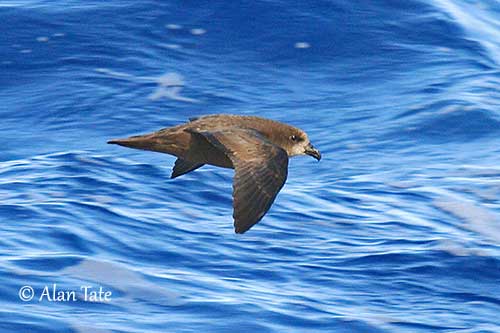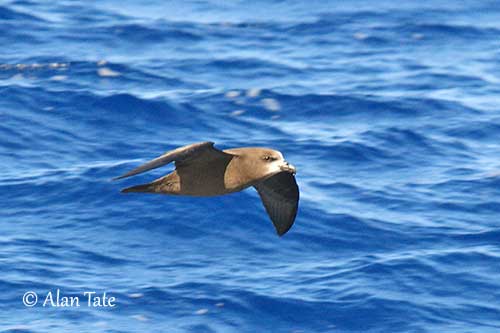
Fr: Pétrel à face grise
Ang: Grey-faced Petrel
All: Gouldsturmvogel
Esp: Petrel carigrís
Nd: Grijsmaskerstormvogel
Sd: gouldpetrell
Photographers:
John Anderson
John Anderson Photo Galleries
Otto Plantema
Trips around the world
Alan & Ann Tate
AA Bird Photography
Text by Nicole Bouglouan
Sources:
HANDBOOK OF THE BIRDS OF THE WORLD vol 1 by Josep del Hoyo-Andrew Elliot-Jordi Sargatal - Lynx Edicions - ISBN: 8487334105
A Complete Guide to Antarctic Wildlife by Hadoram Shirihai and Illustrated by Brett Jarrett - Edited by Guy M. Kirwan - ALUL.A Press Oy, Finland - ISBN 9519894705
Tiritiri Matangi Open Sanctuary
New Zealand birds and birding (Narena Olliver)
BREEDING BIOLOGY OF THE GREY-FACED PETREL
Best practice techniques for the translocation of grey-faced petrels
Return of the Grey-Faced Petrel
What Bird-The ultimate Bird Guide (Mitchell Waite)
Wikipedia, the free encyclopaedia
Page family Procellariidae
Summary cards
Grey-faced Petrel
Pterodroma gouldi
Procellariiformes Order – Procellariidae Family
INTRODUCTION:
The Grey-faced Petrel was formerly a subspecies of the Great-winged Petrel, but it is now a full species since 2014. Both species differ in size of extend of the pale area on face, more extensive and better demarcated on the present species P. gouldi.
The Grey-faced Petrel is found in New Zealand where it breeds on many islands. Like most Procellariidae, it nests in burrows and forms colonies between March and January. Both adults share the nesting duties.
They feed on aquatic prey such as squid, crustaceans and fish. It forages mainly at night but also during the day. They can cover large distances while searching for food.
The Grey-faced Petrel is described as reasonably abundant, despite predation by cats, rats, stoats and skuas, involving declines in some areas. But currently, the Grey-faced Petrel is not listed as globally threatened.

DESCRIPTION OF THE BIRD:
Biometrics:
Length: 42-45 cm
Wingspan: 105-113 cm
Weight: 595-750 g
The Grey-faced Petrel is a large, dark, gadfly petrel. The wings are long and narrow and the long tail is pointed.
It has uniform dark blackish-brown body plumage, sometimes with pale areas in worn plumage. There is a pale grey to buff-white area around the bill, extending to the throat and often to the forecrown. A restricted dark area is visible in front of the eye.
The stout bill is black (33-40 mm length) with a sharply hooked tip, well-adapted to catch squid. The eyes are dark brown. Legs and webbed feet are black.
Male and female are similar.
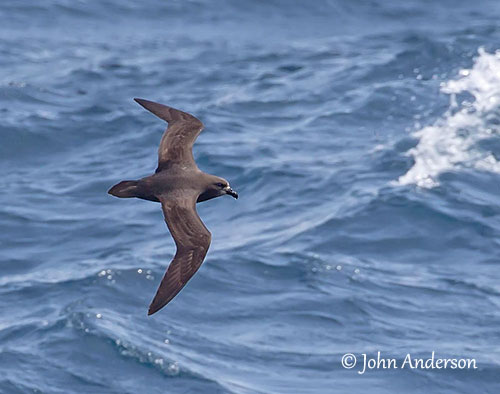
The chick is covered in thick greyish-brown down. The black bill is heavy. Legs and feet are greyish-white.
The juvenile resembles adult and the pale area on face is visible.
RANGE:
The Grey-faced Petrel breeds on numerous islands, headlands and clifftops along W, N and NE coasts of the North Island in New Zealand. During the breeding season, they mainly forage in the Tasman Sea or E of New Zealand.
During the summer and the moulting period, they disperse across the Tasman Sea to the coasts of Australia, and some of them may reach the Coral Sea.
HABITAT:
The Grey-faced Petrel is a highly pelagic seabird that comes ashore only for breeding. The small colonies are scattered and established around the coasts on headlands and peninsulas adjacent to sea. They nest in burrows under forest trees, grass or shrubland, often near cliffs above the sea.
CALLS AND SONGS: SOUNDS BY XENO-CANTO
The Grey-faced Petrel gives high-pitched whistles when in flight, described as “whis-her, wik-wik” but we can also hear low moans “oor-wik”. The same vocalisations are also given on water surface and from the burrow.
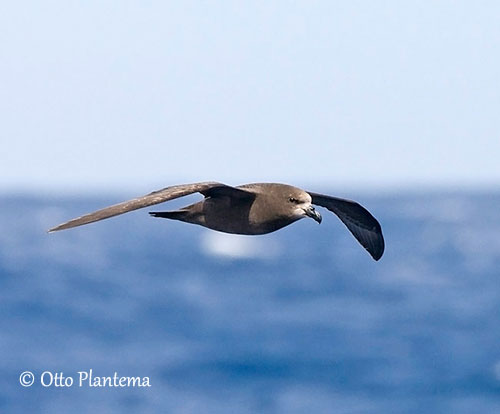
BEHAVIOUR IN THE WILD:
The Grey-faced Petrel feeds primarily on squid, but it also eats crustaceans and fish.
It catches the smaller squids alive on water surface, whereas the larger squids are probably scavenged when dead items are floating on water.
They usually feed at night, but they are frequently observed at sea during the day, probably catching prey.
They usually feed in the first five metres of the water column, although they are able to perform occasional deeper dives, maybe down to 20 metres depth. When feeding at night, they probably detect some prey by bioluminescence.
The Grey-faced Petrel often forages alone and occasionally in small flocks. They may sometimes follow cetaceans.
The breeding sites are very noisy in April/May and in August. At night, they are very active at the breeding grounds, calling and prospecting for burrows, and also displaying.
These birds perform spectacular aerial chases over the colony. During the courtship period, the males spend more time in the burrows than the females which are usually absent for two months during the pre-laying period. On the other hand, the males are absent for seven weeks prior to the incubation. The copulation probably occurs before these absences, thanks to the prolonged viability of the spermatozoa, and the ovulation takes probably place some times before the laying.
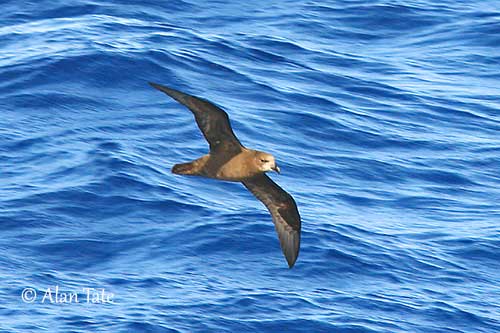
Between October and April, the Grey-faced Petrel can be seen in W Tasman Sea off New South Wales. It has been recorded in SW Pacific, N to seas S of New Caledonia. There are two records off C California in 1986 and 1988.
And more generally, after breeding, they disperse to warmer waters in N Tasman Sea or off S and E Australia.
When at sea, the Grey-faced Petrel flies rapidly and can cover large distances while searching for food. It flies with deep, strong wingbeats and long glides.
REPRODUCTION OF THIS SPECIES:
The laying occurs late June/July, but rarely after mid-July.
The Grey-faced Petrel nests in a self-excavated burrow, above the ground, in rock crevice, under scrubs, grass or among tree roots. It is about 60-290 cm long. The nest chamber is at the end of this long burrow, lined with leaves and twigs.
The female lays a single white egg. Both adults incubate during 51-58 days (55) with three stints of 17 days, with two by the male. At hatching, the chick is covered in brown-grey down, and we can see some bare, pale grey skin on face. Both parents feed the young that fledges about 108/128 days after hatching, with a weight of 470/600 grams. It is independent at fledging.
The immature returns to the colony at 3 years of age, but it usually breeds around 8-10 years old.
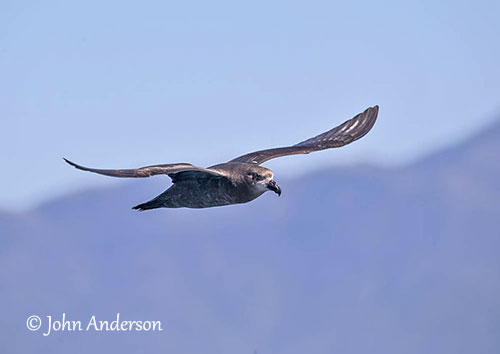
PROTECTION / THREATS / STATUS:
The Grey-faced Petrel is mainly affected by predators on the breeding grounds, including invasive mammalian animals such as cats, rats, stoats and pigs, involving the decline of the population. Eradication of both cats and Polynesian rats resulted in an increase of the numbers, but other cats and rat species still remain on several islands. Illegal harvest on some offshore islands still occurs but remains sustainable.
The global population is roughly estimated at 600,000/900,000 individuals. It is suspected to be declining due to the previous threats.
However, the species is not considered globally threatened, and the Grey-faced Petrel is currently evaluated as Least Concern.
